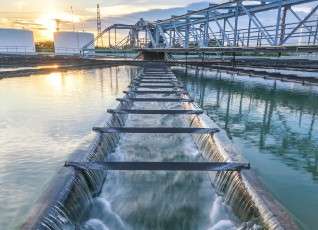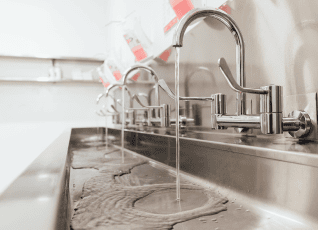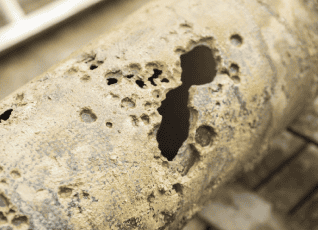The Broader Impact of Effective Water Management

Water safety is often focused only on Legionella control, but an effective program can provide a much wider range of benefits. Water quality influences not only occupant health but also the performance of infrastructure, long-term sustainability goals, and financial outcomes. When facilities rely on outdated or incomplete water management strategies, they leave themselves vulnerable to risks that go well beyond Legionella. A smarter approach, grounded in a multi-barrier water management strategy, offers a way to protect people, extend equipment life, reduce operational costs, and support sustainability. Why traditional water treatment methods fall short Many facilities continue to lean on conventional practices such as flushing, temperature monitoring, and municipal disinfectant residuals. While these measures are widely used, they rarely address the real drivers of waterborne pathogen risk. Biofilm and sediment shield bacteria from disinfectants, temperature control is ineffective, cold water risks are overlooked, and flushing programs often require significant time and energy without producing lasting results. The cycle of monitoring and corrective actions that results from these methods is not just inefficient; it can mask bigger problems, such as hidden sediment accumulation or corrosion that undermines water quality throughout a building. The overlooked role of sediment Sediment is an underestimated challenge in building water systems. Sediment is naturally present in source water and often introduced through water main breaks, construction activity, or corrosion within pipes. Once inside, it quietly disrupts both water quality and infrastructure: Sediment-induced damage Broader impacts on facilities Poor water management is not just a safety concern; it affects every part of a facility’s operation. This interconnected risk landscape is why leading facilities are rethinking their approach with multi-barrier solutions that go beyond Legionella and compliance. Smarter water management A multi-barrier approach layers proven technologies with expert service to create a comprehensive, defensible water management strategy. Together, these measures protect both people and infrastructure: These technologies are integrated into a program supported by data analytics and remote monitoring, ensuring that facility teams can act proactively instead of reactively. Real-world results The benefits of this approach are measurable. In one academic medical center, implementing a multi-barrier solution allowed hot water heaters to be lowered from 160°F to 125°F while still achieving non-detect Legionella results, cutting energy use by 50%. Another facility reduced sediment loads by nearly 98%, preventing costly pump failures and improving system reliability. Even more importantly, infection risk was significantly reduced. One facility saw complete elimination of Pseudomonas, Acinetobacter, and Stenotrophomonas detections, improving patient safety and reducing the burden of HAIs. Rethink water safety for the future Water is more than a utility; it’s a clinical, operational, and financial risk factor. By addressing underlying issues like sediment and biofilm with smarter, layered protection, facilities can safeguard their people, extend equipment life, and achieve long-term results. If your current water management strategy feels like a cycle of short-term fixes, it may be time to take a smarter approach. Connect with a LiquiTech water safety expert today to explore how a multi-barrier strategy can transform your facility’s water quality and performance.
From Source to Tap: Navigating Building Water Quality

Water traveling from municipal sources to a building’s taps undergoes a complex journey influenced by everything from the quality of the source water to the building’s internal distribution network. Even water that meets national safety standards can encounter challenges as it passes through aging pipes, is affected by shifting climates, and interacts with building infrastructure. Understanding these factors—and taking proactive steps to address them—is essential for ensuring safe, reliable, and sustainable water. Understanding source water quality The foundation of safe drinking water in the U.S. is the Safe Drinking Water Act (SDWA), which mandates the EPA to set health-based standards for public water supplies. While compliance with SDWA ensures water is safe to consume, it doesn’t guarantee that water entering a building’s plumbing system is free of all contaminants or pathogens. Once water leaves the municipal water treatment plant and enters the distribution system, the quality of the water can change drastically before it reaches a building, leaving building water systems susceptible to issues like scale, corrosion, and even microbial growth. Growing challenges influencing source water quality Leveraging water quality reports Consumer Confidence Reports (CCRs) are annual water quality reports issued by municipalities to inform consumers about the safety and quality of their drinking water. By reviewing these reports, engineers and facility managers can anticipate challenges such as scaling, corrosion, or bacterial growth and adjust water treatment protocols accordingly. How source water quality impacts buildings Solutions for optimal water quality To mitigate risks and ensure high-quality water throughout building systems, you must adopt proactive and multi-faceted strategies. Here are some proven solutions: 1. Supplemental disinfection systems: Installing secondary disinfection systems can help control microbial growth beyond the municipal supply. Options like UV disinfection can target pathogens like Legionella without contributing to harmful DBPs or accelerating corrosion. 2. Flushing programs: Regular flushing of plumbing systems removes stagnant water, sediment, and biofilm. A well-designed flushing program includes low-use fixtures, distal outlets, and hot water recirculation loops to prevent microbial growth and ensure disinfectant efficacy. 3. Sediment filtration: Point-of-entry sediment filtration systems capture particulates and sediment before they enter the building’s plumbing, reducing strain on equipment, minimizing scale formation, and improving water clarity. 4. Water softeners: By reducing hardness, softeners prevent scaling and improve the efficiency of water-dependent systems. This is particularly critical in areas with high sediment or hard water. 5. Smart monitoring: Modern IoT-enabled sensors can provide real-time insights into water quality metrics such as temperature, pH, chlorine residuals, and microbial activity. Automated alerts enable facility teams to respond quickly to emerging issues. Standards, best practices, and emerging trends Standards and best practices Several modern guidelines provide a framework for water quality management: Emerging trends Making water quality a strategic priority Water quality is not just a technical challenge—it’s a strategic priority. Poor water quality can compromise building performance, increase operational costs, and endanger occupant health. By leveraging tools like CCRs, adhering to best practices, and investing in advanced water management solutions, you can ensure that your water systems deliver safe, efficient, and sustainable water. Partner with LiquiTech to lead the way in advanced water intelligence. Together, we can transform your building’s water systems. Contact us today to get started.
Plumbing 201 for Infection Preventionists: The Impact of Plumbing on Healthcare

Healthcare facilities are tasked with preventing the spread of healthcare-associated infections (HAIs), and the intricacies of plumbing design and material selection play a significant role in this effort. The role of biofilm in promoting bacteria and pathogens in healthcare water systems including drains and the link between drinking water outbreaks like Legionella to biofilm in plumbing systems, and the importance of selecting the right materials for supply lines are all pivotal in curbing the risk of HAIs. The role of plumbing in infection control Understanding the interaction between plumbing materials and microbial growth is imperative for Infection Preventionists (IPs). Making informed choices during construction and renovation allows for the selection of materials that not only minimize infection risks but also ensure compliance with health and safety standards. By collaborating effectively with facility management, IPs can significantly contribute to joint infection control initiatives, ensuring that plumbing systems do not become a source of infection. Key plumbing terms to understand Infection prevention requires a firm grasp of key plumbing concepts that impact patient safety. Understanding terms such as leaching, corrosion, and biofilms enriches an IP’s toolkit, allowing for better mitigation of risks associated with waterborne infections. Leaching The process by which materials, such as metals or chemicals, dissolve or are washed out from the pipe material into the water due to contact with the water over time. In healthcare settings, leaching can introduce potentially harmful substances into the water supply, affecting water quality and patient safety. Corrosion The gradual destruction or deterioration of materials (metals, alloys, plastics, etc.) caused by chemical reactions with their environment. In pipes, corrosion can lead to reduced water flow, leaks, and the release of metals into the water, which can serve as nutrients for microbial growth, including biofilms. Biofilm A complex aggregation of microorganisms, including bacteria, fungi, and protozoa, that adhere to each other and surfaces, encased in a protective and adhesive matrix. Biofilms in plumbing systems can harbor pathogens, making them resistant to disinfection and posing a significant risk for HAIs. Types of lines: Supply, return, drain, waste Plumbing systems consist of multiple types of lines, each with a distinct function. Here, we explore supply lines, return lines, drain lines, and waste lines. Grasping the role of each type is vital for maintaining an efficient, safe, and reliable plumbing system. Supply lines The integrity of plumbing supply lines is critical in delivering safe, potable water for drinking, handwashing, and patient care activities. Materials like copper, PEX, and CPVC are chosen for their durability and reliability. Flexible water supply pipes offer installation ease and adaptability, making them an excellent choice for connecting water supplies to fixtures in constrained spaces. Their construction from materials like stainless steel, PVC, or braided nylon offers durability and resistance to corrosion, ensuring reliable performance over time. Return lines Equally important are the plumbing return lines, which ensure the efficient operation and delivery of potable water systems. They contribute to patient comfort and infection control by reducing water age and stagnant conditions, preventing sediment accumulation, and ensuring temperature and disinfectant residuals. Drain and waste lines Proper sanitation in healthcare facilities hinges on effectively removing wastewater and materials through well-designed drain and waste lines. Choosing the right materials, such as PVC or cast iron, and ensuring their correct installation and maintenance are key factors in preventing backflows and the spread of pathogens. Types of plumbing material and their impact on patient safety Exploring the benefits and potential risks associated with commonly used plumbing materials—including copper, stainless steel, cast iron, galvanized steel, and various plastics such as PVC, CPVC, and PEX—helps IPs make informed decisions. PVC, CPVC, and PEX are generally not used in healthcare plumbing due to their susceptibility to biofilm formation and potential chemical leaching. These materials can create environments conducive to microbial growth, posing significant infection risks in healthcare settings. Additionally, their lower thermal tolerance and potential for chemical degradation under high-temperature water systems make them less suitable for the stringent plumbing requirements in healthcare facilities. Each material has its advantages, such as antimicrobial properties or corrosion resistance, but also considerations like the need for regular maintenance to prevent contamination. Copper Copper is favored for healthcare plumbing because of its antimicrobial qualities and durability. It lowers microbial levels in water systems and keeps water quality high with a lower risk of contamination, however over time, it can lose these properties due to scale and sediment accumulation. Used in drinkable water lines, both hot and cold, copper helps reduce infections associated with healthcare. Regular checks and maintenance are needed to avoid bacterial contamination from damaged pipes. Despite its initial cost, copper’s health advantages and long-term use can make it a cost-effective choice. Stainless steel Stainless steel is favored in healthcare for its corrosion resistance, hygiene, and durability. Its non-porous surface helps reduce bacterial growth and biofilm, promoting a cleaner water supply and helping prevent HAIs. Despite higher initial costs, its longevity and minimal replacement needs make it a cost-effective choice. Regular maintenance, including inspections and proper cleaning, is crucial for its long-term use. Stainless steel plays a vital role in maintaining patient safety in healthcare settings. Cast iron Cast iron pipes, commonly used for underground plumbing due to their durability and sound-dampening qualities, are mainly used in drainage and vent systems. Over time, these pipes may corrode, risking water contamination and health hazards. Therefore, regular checks and upkeep are crucial. Despite potential risks, when well-maintained, cast iron pipes remain a good choice for healthcare facilities, offering high crush strength and noise reduction, which is important for patient comfort. Prioritizing patient safety in healthcare plumbing material selection is key. Galvanized steel Once popular for their corrosion resistance, galvanized steel pipes can degrade over time. The zinc coating may wear off, leading to rust and bacterial growth. In healthcare settings, these pipes are unsuitable for drinking water systems due to potential water quality issues and health risks. Modern facilities prefer safer materials to reduce risks. Regular maintenance, including corrosion checks, water tests for
Corrosion: What Is It and How to Control It

What is corrosion? Corrosion is the degradation or deterioration of a material caused by a reaction to its environment. In building plumbing systems, corrosion can occur in our piping systems and water-bearing equipment due to reactions, chemicals, and impurities in the water. These processes result in uniform corrosion, pitting, cracking, or erosion, ultimately causing the breakdown and failure of the piping system and components. How does it impact plumbing? Corrosion significantly impacts the plumbing system, operations, maintenance, costs, and equipment. It can lead to pinhole leaks in the piping and pipe blowouts, which can ultimately cause water damage to the surrounding area. Corrosion can also cause loss of efficiency, reduction in performance, blockages, and total equipment failure of valves, pipes, pumps, and heaters. All corrosion impacts have significant financial consequences, including pipe and equipment replacement, labor for repairs, maintenance and system interruptions, and downtime. What causes it? The corrosivity and corrosion rate of our building’s water systems depends on several water characteristics, including sediment levels, flow, temperature, chemical treatment programs, and microbial communities. How can it be controlled? Avoiding corrosive water treatment methods, such as chlorine, chlorine dioxide, and monochloramine, will significantly impact the life of plumbing systems. An alternative technology, copper-silver ionization, has greater efficacy against waterborne pathogens and does not increase the corrosivity of the water system. Installing a sediment filtration system on the incoming water supply will significantly reduce the amount of sediment entering the building water system. This protects the water system from sediment accumulation, which can lead to corrosion of equipment and pipes. The filtration system will also protect against external disruptions or surges in sediment, which can build up in a system, erode equipment, and impact equipment life. Case study: Colorado hospital sediment filtration success story Sediment in the incoming water supply caused pinhole leaks, forcing the replacement of two-year-old piping for $80K. Installing a LiquiTech™ Sediment Filtration System reduced sediment entering the building’s water system. Read the full case study here. Sediment levels (96.7% reduction) Download: corrosion fact sheet Fill out the form below to download our corrosion fact sheet to keep on hand or to share with your team.
Control of Legionella Contamination and Risk of Corrosion in Hospital Water Networks Following Various Disinfection Procedures
ISABELLA MARCHESI, GRETA FERRANTI, ANTONELLA MANSI, ANNA M. MARCELLONI, ANNA R. PROIETTO, NAVNEET SAINI, PAOLA BORELLA, ANNALISA BARGELLINIAMERICAN SOCIETY FOR MICROBIOLOGY, APPLIED AND ENVIRONMENTAL BIOLOGY, MAY 2016 IntroductionThis study evaluated four disinfection methods for their efficacy in controlling Legionella and their corrosive effects on water pipes. The four methods included: ResultsLegionella controlOf the four disinfection methods analyzed, monochloramine had the lowest Legionella positivity rate (percentage of test sites positive for Legionella), followed by chlorine dioxide, hydrogen peroxide, and heat. None of the methods eliminated Legionella. The results from the lowest Legionella positivity rate (most effective) to the highest (least effective): CorrosionHydrogen peroxide and chlorine dioxide caused pitting on the pipe’s interior surface. Pitting is a type of corrosion that can lead to holes. Monochloramine and heat appeared to be less aggressive, with monochloramine exhibiting uniform corrosion with the rare formation of pitting. Heat showed corrosion similar to that observed on the untreated samples. ConclusionContinuous chemical disinfection is effective to an extent and is significantly more effective than using only heat, and each modality displayed different morphologies of corrosion. Full report